|
The C2 cameras are designed to work in cooperation with a
host Personal Computer (PC). As opposite to digital still cameras,
which are operated independently on the computer, the scientific
cameras usually require computer for operation control, image
download, processing and storage etc. To operate the camera, you
need a computer which:
Is compatible with a PC standard and runs modern 32 or 64-bit
Windows operating system. Is an x86 or ARM based computer and runs 32 or 64-bit Linux
operating system. Support for x64 based Apple Macintosh computers is also
included.
C2 cameras are designed to be connected with the host PC through
USB 3.0 interface, operating at 5 Gbps. Cameras are also compatible
with USB 2.0 port to communicate with a host PC.
Alternatively, it is possible to use the Moravian Camera
Ethernet Adapter device. This device can connect up to four Cx
(with CMOS sensors) or Gx (with CCD sensors) cameras of any type and
offers 1 Gbps and 10/100 Mbps Ethernet interface for direct connection
to the host PC. Because the PC then uses TCP/IP protocol to
communicate with the cameras, it is possible to insert WiFi adapter or
other networking device to the communication path.
Hint: Please note that the USB standard allows usage of cable no
longer than approx. 5 meters and USB 3.0 cables are even shorter to
achieve very fast transfer speeds. On the other side, the TCP/IP
communication protocol used to connect the camera over the Ethernet
adapter is routable, so the distance between camera setup and the host
PC is virtually unlimited. The C2 cameras need an external 12 V DC power supply to
operate. The wall adapter providing proper voltage is shipped with
every camera.
Note the camera must be connected to some optical system (e.g. the
telescope) to capture images. The camera is capable of long exposures,
necessary to acquire the light from faint objects. If you plan to use
the camera with the telescope, make sure the whole telescope/mount
setup is capable to track the target object smoothly during long
exposures.
C2 Camera Overview
C2 camera head is designed to be easily used with a set
of accessories to fulfill various observing needs. Camera head
itself is manufactured in two different variants:
Camera with Internal filter wheel. Camera with control port for External filter wheel. This
model allows attachment of several variants of external filter
wheels with various number of filter positions and
sizes.
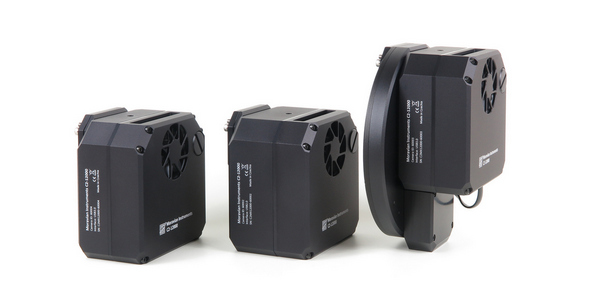
C2 Camera without filter wheel (left), with Internal
filter wheel (middle) and with attached External filter wheel
(right) C2 camera model with Internal filter wheel accepts two
sizes of filters:
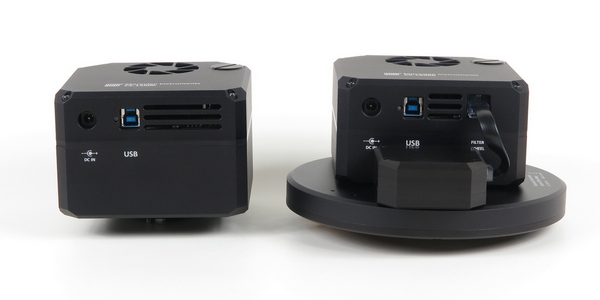
C2 camera with Internal filter wheel (left) and with
External filter wheel attached (right) There are two sizes of the External filter wheels, each
capable to accept multiple sizes of filters, available for the
C2 cameras:
Extra small “XS” size wheel for 8 unmounted
filters D31 mm or filters in 1.25”
threaded cells. Extra small “XS” size wheel for 7 unmounted
filters D36 mm. Small “S” size wheel for 12 unmounted filters
D31 mm or filters in 1.25” threaded
cells. Small “S” size wheel for 10 unmounted filters
D36 mm. Small “S” size wheel for 7 unmounted D50 mm or 2" filter or filters in 2” threaded
cells.
Warning: Please note the camera head is designed to either
accept Internal filter wheel or to be able to connect to the
External filter wheel, but not both. If the Internal filter wheel
variant is used, External filter wheel cannot be
attached. C2 cameras are manufactured with a wide range of CMOS
sensors. Probably the most important differentiating factor,
fundamentally affecting camera operation, is an electronic
shutter implemented in the sensors. C2 cameras support sensors
with:
Global shutter, allowing capturing of the whole
frame in the very same instance of time. This means all pixels
are reset and start to capture light simultaneously. Global
shutter is particularly suitable for capturing fast moving
scenes, because they ensure image does not suffer from motion
distortion, caused by rolling shutter sensors. On the other
side, frame rate of global shutter sensors is lower compared to
rolling shutter ones, because each frame must be fully digitized
prior to start of next exposure. Rolling shutter, which resets individual image
rows in a sequence. The exposure of each image row is delayed
typically by a few tens of microseconds. Depending on this delay
and number of rows, the first and last row exposure time may be
shifted by up to several tenths of a second. The inherent
feature of rolling shutter sensors is a distortion of
fast-moving scenes, when image moves within the time individual
rows are exposed. Luckily such fast moving scenes are very rare
in astronomy. The plus side of rolling shutter is much higher
FPS, as each image is already exposed while the previous image
is digitized.
C2 Camera System
Components of C2 Camera system include:
C2 camera head with Internal Filter Wheel (5 or 6
positions) C2 camera head capable to control External Filter
Wheel External Filter Wheel “XS” size (7 or 8
positions) External Filter Wheel “S” size (10 or 12
positions) C1 guider camera Off-Axis Guider with M48 × 0.75 thread Off-Axis Guider with M42 × 0.75 thread (T2) Thick adapter base, compensating EFW thickness to
achieve proper back focal distance for cameras without
filter wheel 1.75” dovetail rail for C2 camera head Camera Ethernet Adapter (x86 CPU) Camera Ethernet Adapter (ARM
CPU) 5-positions internal filter wheel for 1.25”/D31 mm
filters 6-positions internal filter wheel for 1”/D27 mm
filters 8-positions external filter wheel “XS” for
1.25”/D31 mm filters 7-positions external filter wheel “XS” for D36
mm filters 12-positions external filter wheel “S” for
1.25”/D31 mm filters 10-positions external filter wheel “S” for D36
mm filters 7-positions external filter wheel “S” for
2”/D50 mm filters M42 × 0.75 (T-thread) or
M48 × 0.75 threaded adapters,
55 mm BFD Canon EOS bayonet lens adapter Nikon bayonet lens adapter
C2 with global shutter CMOS Sensors
C2 camera models equipped with Sony IMX global shutter
CMOS detectors with 3.45 × 3.45 μm or 4.50 × 4.50 μm square pixels. Individual models differ in
resolution only.
All used sensors utilize global electronic shutter. This means
every pixel within the image is exposed in the same time, as
opposed to rolling shutter sensors, which exposes individual lines
one after another. There is no difference for long exposures of
static objects, but imaging of moving objects using short exposure
time using rolling shutter leads to image shape distortions.

Illustration of the CMOS global shutter
operation Three lines of C2 cameras are available depending on
the available dynamic range (bit-depth of the digitized pixels)
and pixel size:
C2 cameras with Sony IMX sensors with
3.45 × 3.45 μm pixels, supporting 8- and 12-bit
digitization. Because every 12-bit pixel occupies two bytes
when transferred to host PC, 12-bit image download time is
longer compared to 8-bit image. Maximal FPS in 8-bit mode is
then significantly higher. C2 cameras with Sony IMX sensors with
3.45 × 3.45 μm pixels, supporting 12-bit digitization
only. As the 12-bit read mode is always used for
long-exposure applications (astronomical photography, scientific
research) either way, lower theoretical download time in 8-bit
mode brings no limitations for real-world scenarios. All other
parameters being same (sensor size, resolution, pixels size,
noise, …), lower price of these cameras may be then very
attractive. C2 cameras with Sony IMX sensors with
4.50 × 4.50 μm pixels and
12-bit digitization only. Greater pixels mean higher
dynamic range (more electrons can be stored in each pixel before
it saturates), but also higher read noise. Still the theoretical
S/N is almost the same because of higher signal camera can
accumulate. This camera is more suitable for longer focal length
telescopes, where small pixels provide oversampled images, and
also for research applications, where dynamic range is
important.
C2 camera models with 3.45 × 3.45 μm pixels and 8- and 12-bit digitization:
| Model |
CMOS sensor |
Resolution |
Pixel size |
Image area |
| C2-3000 |
IMX252 |
2064 × 1544 pixels |
3.45 × 3.45 μm |
7.12 × 5.33 mm |
| C2-5000 |
IMX250 |
2464 × 2056 pixels |
3.45 × 3.45 μm |
8.50 × 7.09 mm |
| C2-12000 |
IMX253 |
4112 × 3008 pixels |
3.45 × 3.45 μm |
14.19 × 10.38 mm |
C2 camera models with 3.45 × 3.45 μm pixels and 12-bit
digitization only:
| Model |
CMOS sensor |
Resolution |
Pixel size |
Image area |
| C2-3000A |
IMX265 |
2064 × 1544 pixels |
3.45 × 3.45 μm |
7.12 × 5.33 mm |
| C2-5000A |
IMX264 |
2464 × 2056 pixels |
3.45 × 3.45 μm |
8.50 × 7.09 mm |
| C2-12000A |
IMX304 |
4112 × 3008 pixels |
3.45 × 3.45 μm |
14.19 × 10.38 mm |
C2 camera models with 4.50 × 4.50 μm pixels and 12-bit
digitization only:
| Model |
CMOS sensor |
Resolution |
Pixel size |
Image area |
| C2-7000A |
IMX428 |
3216 × 2208 pixels |
4.50 × 4.50 μm |
14.47 × 9.94 mm |
Camera Electronics
CMOS camera electronics primary role, beside the sensor
initialization and some auxiliary functions, is to transfer
data from the CMOS detector to the host PC for storage and
processing. So, as opposite to CCD cameras, CMOS camera design
cannot influence number of important camera features, like the
dynamic range (bit-depth of the digitized pixels).
Sensor linearity
The sensors used in C2 cameras shows very good linearity in
response to light. This means the camera can be used also for
entry-level research projects, like for instance photometry or
variable stars etc.
Response of the with
3.45 × 3.45 μm pixel sensors (left) and with
4.50 × 4.50 μm pixel sensors (right) Download speed
As already noted, there are two lines of C2 camera
series, differing in the used sensor. The first series with
3.45 × 3.45 μm pixels offers four different read
modes:
8-bit slow mode with ~132 MPx/s digitization
speed 12-bit slow mode with ~72 MPx/s digitization
speed 8-bit fast mode with ~263 MPx/s digitization
speed 12-bit fast mode with ~132 MPx/s
digitization speed
The “A” version of C2 cameras with
3.45 × 3.45 μm pixels offers only single read
mode:
And the “A” version of C2 cameras with
4.50 × 4.50 μm pixels offers also only one read
mode:
The digitization speeds mentioned above are valid for
USB 3.0 connection. Also please note the digitization speeds
do not necessarily lead to corresponding FPS, because every
image downloaded has to be processed and displayed, which also
consumes time. This time is negligible, if slow-scan camera
needs many seconds for image download, but in the case of fast
CMOS cameras, time for image processing in the PC (e.g.
calculation of image standard deviation etc.) can be longer
than image download itself.
Camera gain
Sensors used in C2 cameras offer programmable gain from 0
to 24 dB, which translates to the output signal multiplication
from 1× to
15.9×. Gain can
be set with 0.1 dB step.
Conversion factors and read noise
Generally, many sensor characteristics depend on the used
gain. Hence, we provide two lists of parameters for both
minimal and maximal gain.
Camera/sensor parameters for sensors with
3.45 × 3.45 μm pixels:
| Digitization resolution |
12-bit |
12-bit |
8-bit |
8-bit |
| Sensor gain |
0 dB |
24 dB |
0 dB |
24 dB |
| Full well capacity |
11000 e- |
1100 e- |
2600 e- |
1100 e- |
| Conversion factor |
2.8 e-/ADU |
0.3 e-/ADU |
10.0 e-/ADU |
4.4 e-/ADU |
| Read noise |
2.2 e- RMS |
2.0 e- RMS |
4.2 e- RMS |
9.7 e- RMS |
Camera/sensor parameters for sensors with
4.50 × 4.50 μm pixels:
| Digitization resolution |
12-bit |
12-bit |
| Sensor gain |
0 dB |
24 dB |
| Full well capacity |
26000 e- |
2100 e- |
| Conversion factor |
6.3 e-/ADU |
0.5 e-/ADU |
| Read noise |
5.3 e- RMS |
3.9 e- RMS |
Exposure control
C2 cameras are capable of very short exposures. The
shortest exposure time is 125 μs (1/8000
of second). This is also the step, by which the exposure time
is expressed. So, the second shortest exposure is 250 μs etc.
Long exposure timing is controlled by the host PC and there
is no upper limit on exposure time. In reality the longest
exposures are limited by saturation of the sensor either by
incoming light or by dark current (see the following
sub-chapter).
Mechanical shutter
C2 cameras are equipped with mechanical shutter, which
is an important feature allowing unattended observations
(fully robotic or just remote setups). Without mechanical
shutter, it is not possible to automatically acquire dark
frames, necessary for proper image calibration etc.
Mechanical shutter in the C2 cameras is designed to be
as reliable as possible, number of open/close cycles is
virtually unlimited, because there are no surfaces rubbing
against each other. The price for high reliability is slow
shutter motion. Luckily, mechanical shuttering is not
necessary for exposure control, only for taking dark
frames and possibly bias frames — all used CMOS sensors are equipped with
electronic shuttering.
Camera firmware optimizes the shutter operation to
avoid unnecessary movements. If a series of light images
is taken immediately one after another, the shutter
remains open not to introduce quite significant delay of
the close/open cycle between subsequent light images. If
the next image is a dark or bias frame, shutter closes
prior to exposure and vice versa — shutter remains closed if a series of dark
frames is acquired and opens only prior to next light
frame. If no exposure is taken for approx. 5 seconds while
the shutter is open, camera firmware closes the shutter to
cover the sensor from incoming light.
GPS exposure timing
The C2 cameras with global shutter can be equipped with
GPS receiver module (see the Optional Accessories
chapter). The primary purpose of the GPS receiver is to
provide precise times of exposures taken with the camera,
which is required by applications dealing with astrometry
of fast-moving objects (fast moving asteroids, satellites,
and space debris on Earth orbit, ...).
The GPS module needs to locate at last 5 satellites to
provide exposure timing information. Geographic data are
available if only 3 satellites are visible, but especially
the mean sea level precision suffers if less than 4
satellites are used.
The camera SDK provides functions, allowing users to
access precision exposure times as well as geographics
location. The SIPS software package main imaging camera
control tool window contains the “GPS” tab, which
shows the state of the GPS fix.

SIPS offers GUI to determine the state the GPS
receiver A huge advantage of the global-shutter CMOS sensors,
compared to rolling-shutter ones, is very simple and
straightforward way to determine the exact exposure time.
As opposed to rolling-shutter sensors, all pixels are
exposed at exactly the same time, returned by the GPS
receiver, and there is no need to calculate with line time
and pixel y-coordinate.
Remember to always use the latest version of SIPS or
latest camera drivers (ASCOM or Camera SDK DLLs in
Windows, INDI or libraries in Linux) available on the web.
Also, always update the firmware in the Moravian Camera
Ethernet Adapter if the camera is connected over
Ethernet.
C2 with rolling shutter CMOS Sensors
C2 series of CMOS cameras with Sony IMX rolling shutter CMOS
detectors currently contain single model with Sony IMX533 sensor
with pixel size 3.76 × 3.76 μm:
| Model |
CMOS sensor |
Resolution |
Pixel size |
Image area |
| C2-9000 |
IMX533 |
3008 × 3008 pixels |
3.76 × 3.76 μm |
11.31 × 11.31 mm |
As opposed to global-shutter sensors, rolling-shutter sensors
expose individual lines in sequence.

Illustration of the CMOS rolling shutter operation for
individual exposures 
Illustration of the CMOS rolling shutter operation for
serial exposures Camera Electronics
Controlling of the rolling shutter sensors differs
significantly from controlling of the global shutter sensors
and thus the camera C2-9000 internals are quite different from
other C2 models.
The C2-9000 contains 256 MB of
onboard memory, capable to store up to 14 full-resolution
frames. Camera API allows for sequential exposures, during
which short-exposure images are stored into memory possibly
faster than the host computer is able to read them. Sequential
exposures are paused when the internal memory is filled with
images, not yet read by the host PC. As explained earlier,
rolling shutter sensors are capable to perform image exposure
while digitizing the previous image.
Sensor linearity
The IMX533 sensor used in C2-9000 camera shows very good
linearity in response to light. This means the camera can be
used for advanced research projects, like the photometry of
variable stars and transiting exoplanets etc.
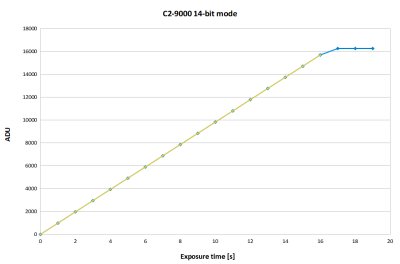
Response of the Sony IMX rolling-shutter sensor
(IMX533) Download speed
Thanks to C2-9000 onboard RAM, downloading of the image to
the host computer does not influence image digitization
process, as the download only transfers already digitized
images from camera memory.
Time needed to digitize and download single full
frame depends on USB connection type.
Full-frame, USB 3.0
(5 Gbps):
0.06 s Full-frame, USB 2.0
(480 Mbps):
0.40 s
If only a sub-frame is read, time needed to
digitize and download image is naturally lower. However, the
download time is not cut proportionally to number of pixels
thanks to some fixed overhead time, independent on the
sub-frame dimensions.
1024 × 1024 sub-frame,
USB 3.0 (5 Gbps): 0.02 s 1024 × 1024 sub-frame,
USB 2.0 (480 Mbps): 0.05 s
Hint: The driver is sometimes forced to read bigger
portions of the sensor than the user defined because of a
sub-frame position and dimension limitations imposed by the
sensor hardware. Sometimes it is even necessary to read a
whole sensor. It is recommended to click the Adjust
Frame button in the Frame tab of the SIPS camera
control tool. The selected frame dimensions are then adjusted
according to sensor limitations. Adjusted frame is then read
from the sensor, without a necessity to read a bigger portions
or even whole sensor and crop image in firmware. C2-9000 camera electronics supports in-camera
2 × 2 binning. If this binning
mode is used, download speed increases because of less
amount of data read from camera.
Full-frame 2 × 2
binning, USB 3.0 (5 Gbps): 0.03 s Full-frame 2 × 2
binning, USB 2.0 (480 Mbps): 0.11 s
Download speed when using the Moravian Camera Ethernet
Adapter depends if the 100 Mbps
or 1 Gbps Ethernet is used, if
USB 2 or USB 3 is used to connect camera to Ethernet
Adapter device, but also depends on the network utilization
etc. When the camera is connected to the Ethernet Adapter
using USB 3 and 1 Gbps Ethernet is directly connected to the
host PC, download time of the C2-9000 full frame is less than
0.5 s.
Camera gain
Rolling shutter sensor used in C2 cameras offers
programmable gain from 0 to 36 dB, which translates to the
output signal multiplication from 1× to 63×.
Camera driver accepts gain as a number in the range 0 to
4030, which corresponds directly to sensor register value.
This number does not represent gain in dB nor it is an exact
gain multiply. However, the driver offers a function, which
transforms the gain numerical value to gain expressed in dB as
well as multiply. Some selected values are shown in the
table:
| Gain number |
Gain in dB |
Gain multiply |
| 0 |
0.00 |
1.00× |
| 1000 |
2.34 |
1.32× |
| 2000 |
5.82 |
1.95× |
| 3000 |
11.46 |
3.74× |
| 4000 |
32.69 |
43.11× |
| 4030 |
35.99 |
63.00× |
Conversion factors and read noise
Generally, many sensor characteristics depend on the used
gain. Also, the used sensors employ two conversion paths. One
path offers very low read noise, but cannot utilize full
sensor dynamic range. Another conversion path offers maximum
pixel capacity, but at the price of higher read noise. The
cross point is set to gain 3×
(approx. 10 dB), where the full
well capacity drops from more than 50 ke- to ~17 ke-. The read noise then drops from
~3.2 e- RMS to
~1.5 e- RMS.
| Gain number |
Gain in dB |
Gain multiply |
Conversion factor |
Read noise RMS |
Full well capacity |
| 0 |
0.0 dB |
1× |
3.10 e-/ADU |
3.81 e- |
50,800 e- |
| 2749 |
9.7 dB |
3× |
1.02 e-/ADU |
3.03 e- |
16,500 e- |
| 2750 |
9.7 dB |
3× |
1.02 e-/ADU |
1.55 e- |
16,500 e- |
| 4030 |
36.0 dB |
63× |
0.69 e-/ADU |
1.46 e- |
11,400 e- |
Sensor dynamic range, defined as full well capacity
divided by read noise, is greatest when using gain 0,
despite somewhat higher read noise:
At gain = 0, dynamic range is
50,800 / 3.81 = 13,333× At gain = 2750, dynamic range is
16,500 / 1.55 = 10,645×
Also, it is worth noting that in reality the noise floor is
not always defined by read noise. Unless the camera is used
with very narrow narrow-band filter (with FWHM only a few nm)
and under very dark sky, the dominant source of noise is the
sky glow. When the noise generated by sky glow exceeds
approximately 4 e- RMS, extremely
low read noise associated with gain set to 2750 or more is not
utilized and dynamic range is unnecessarily limited by the
lowered full well capacity.
So, which gain settings is the best? This depends
on the particular task.
Gain set to 2750 can be utilized if imaging through
narrow-band filter with appropriately short exposures, so
the background noise does not exceed the read noise. This is
typical for aesthetic astro-photography, where the lowered
full well capacity does not negatively influence the result
quality. But even without narrow-band filters, the
extremely low read noise allows stacking of many short
exposures without unacceptable increase of the stacked image
background noise, caused by accumulation of high read noise
of individual exposures. Gain set to 0 offers maximum full well capacity and
the greatest sensor dynamic range, which is appreciated
mainly in research applications. Pass-bands of filters used
for photometry are relatively wide and dominant source of
noise is the sky glow. But also for RGB images, used
for aesthetic astro-photography, higher dynamic range allows
longer exposures while the bright portions of the nebulae
and galaxies still remain under saturation and thus can be
properly processed.
Binning
The camera driver and user’s applications offer wide
variety of binning modes up to 4 × 4 pixels as well as all combinations of
asymmetrical binning modes 1 × 2,
1 × 3, 1 × 4, 2 × 4
etc. To allow such flexibility, binning is performed only in
the camera driver (software binning) and does not rely on the
limited capabilities of the hardware binning.
The negative side of software binning is the same download
time like in the case of full-resolution 1 × 1 mode. For typical astronomy usage, the
small fraction of second download time is irrelevant, but for
applications sensitive to download time, the hardware
2 × 2 binning can be useful.
Hardware binning
The C2-9000 camera implements 2 × 2 binning mode in hardware in
addition to normal 1 × 1
binning.
Hardware binning can be turned on and off using the
parameter HWBinning in the 'cXusb.ini'
configuration file, located in the same directory like the
'cXusb.dll' driver DLL file itself.
[driver]
HWBinning = true
When the HWBinning parameter is set to
true, the in-camera hardware binning is used. This mode
brings faster download time, but also introduces several
restrictions:
Maximal binning is limited to 2 × 2, higher binning modes are not
available. Asymmetrical binning modes (1 × 2, 2 × 1, ...) are not allowed.
Adding vs. averaging pixels
The traditional meaning of pixel binning implies adding
of binned pixels. This originated in CCD sensors, where
pixel charges were literally poured together within the
sensor horizontal register and/or the output node. Binning
with CMOS sensors can behave differently, pixels can be
either added or averaged.
In theory, the resulting S/N ratio of binned
pixel remains the same regardless if we add or average
them. Let's take for example 2 × 2 binning:
If we add 4 pixels, signal increases 4-times and
noise increases 2-times — three
additive operations increase noise by
√((√2)^2×(√2)^2 ). Resulting S/N
increases 2-times, but only until the sum of all pixels
is lower than the pixel capacity. If we average 4 pixels, signal remains the same
but the noise is lowered to 1/2 as noise is averaged
√((√2)^2×(√2)^2 )/4. Resulting S/N
also increases 2-times, but only until the noise
decreases to lowest possible 1-bit of dynamic
range.
But in reality, resulting S/N ratio can be affected
either by overflow (saturation) of resulting pixel when
adding binned pixels or by read noise underflow (dropping
below 1 bit) when averaging
them.
While the bigger siblings of the C2-9000 camera
(C1×, C3 and C5) utilize
CMOS sensors with full 16-bit dynamic resolution, the
sensor used in C2-9000 offers only 14-bit conversion. So,
up to 4 pixels (2 × 2
binning) can be added and still the resulting pixel cannot
overflow the 16-bit dynamic range of each 2 bytes long pixel. This is why the
default binning behavior of the C2-9000 camera uses pixel
adding instead of averaging on both software binning and
in-camera (hardware) binning.
However, both software and hardware binning modes can
be switched to sum binned pixels instead of average them
by the BinningSum parameter in the
'cXusb.ini' configuration file:
[driver]
BinningSum = true
Let’s note there is one more possibility to bin
pixels — in the application
software. This time binning is not performed in camera
hardware nor in the camera driver. Full resolution
1 × 1 image is downloaded
from the camera and software itself then performs binning.
The SIPS software adds pixels instead of averaging them,
but at the same time SIPS converts images from 16-bit to
32-bit dynamic range. This means S/N of the binned images
always increases, pixels never saturate and read noise
newer approaches lower limit. The negative side of this
option is two-time bigger images.
Binning in photometry
Saturated pixels within bright stars are no issue for
aesthetic astro-photography, but photometry measurement is
invalid if any pixel within the measured object reaches
maximum value, because it is not possible to determine the
amount of lost flux. Software performing photometry (e.g.
the SIPS Photometry tool) should detect saturation value
and invalidate entire photometric point not to introduce
errors.
But binning efficiently obliterates the fact that any
of the binned pixels saturated (with the exception of all
binned pixels reached saturation value). So, using of
binning modes for research applications (photometry and
astrometry) can lead to errors caused by lost flux in
saturated pixels, which cannot be detected by the
processing software due to binning.
This is why the behavior of both software and hardware
binning modes is user-configurable through the
BinningSaturate parameter in the
'cXusb.ini' configuration file:
[driver]
BinningSaturate = true
If the BinningSaturate parameter is set to
true, resulting binned pixel is set to saturation value if
any of the source pixels is saturated. For aesthetic
astro-photography, keeping this parameter false could
result into slightly better representation of bright star
images, but for research applications, this parameter
should always be set to true.
Exposure Control
The shortest theoretical exposure time of the C2-9000
camera is 49 μs. However, such short exposures have no
practical application, especially in astronomy. The camera
firmware rounds exposure time to a multiply of 100 μs intervals, so in
reality the shortest exposure time is also 100 μs.
There is no theoretical limit on maximal exposure length,
but in reality, the longest exposures are limited by
saturation of the sensor either by incoming light or by dark
current (see the following chapter about sensor cooling).
Mechanical shutter
Mechanical shutter of the C2-9000 camera works exactly
the same way like in the case of global-shutter C2
variants.
GPS exposure timing
C2 cameras can be equipped with GPS receiver module
(see the Optional Accessories chapter). The primary
purpose of the GPS receiver is to provide precise times of
exposures taken with the camera, which is required by
applications dealing with astrometry of fast-moving
objects (fast moving asteroids, satellites, and space
debris on Earth orbit, …).
The GPS module needs to locate at last 5 satellites to
provide exposure timing information. Geographic data are
available if only 3 satellites are visible, but especially
the mean sea level precision suffers if less than 4
satellites are used.
The camera SDK provides functions, allowing users to
access precision exposure times as well as geographics
location. The SIPS software package main imaging camera
control tool window contains the “GPS” tab, which
shows the state of the GPS fix.
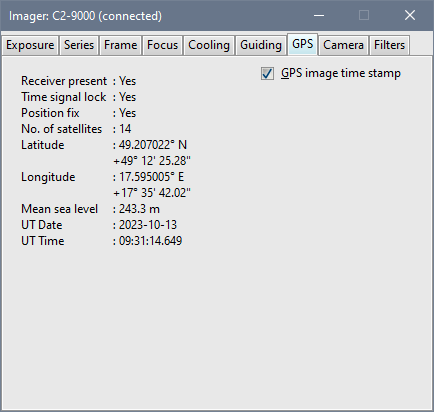
SIPS offers GUI to determine the state the GPS
receiver Determination of exact exposure time is quite
complicated because of the rolling-shutter nature of the
used sensors. Camera driver does all the calculations
and returns the time of the start of exposure of the
first line of the image. Still, users interested in
precise exposure timing need to include several
corrections into their calculations:
- Individual image lines are exposed sequentially. The
time difference between start of exposure of two
subsequent lines is 12.194 μs (this time is determined by the used
IMX533 sensor).
If the image is binned, single line of resulting
image contains signal from multiple added (or averaged)
lines, each with different exposure time start. The
exposure start of individual lines of the binned images
differs by the single line time difference, multiplied
by the vertical binning factor. If only a sub-frame is read, it must be
considered that the sensor imposes some restrictions to
the sub-frame coordinates. If the required sub-frame
coordinates violate the sensor-imposed rules, camera
driver enlarges the sub-frame region to fully contain
desired sub-frame and then crops it by software. The
provided start exposure time then concerns the first
line actually read from the camera, not the first line
of the resulting (software cropped) image. Note
the camera SDK offers function AdjustSubFrame,
which returns the smallest sub-frame, fully containing
the requested sub-frame, but also fulfilling the
sensor-imposed sub-frame coordinate restriction. If
adjusted sub-frame is read, no software cropping occurs
and image exposure time concerns the first line of the
image. The SIPS software offers the “Adjust
Frame” button, which adjusts defined sub-frame.
Remember to always use the latest version of SIPS or
latest camera drivers (ASCOM or Camera SDK DLLs in
Windows, INDI or libraries in Linux) available on the web.
Also, always update the firmware in the Moravian Camera
Ethernet Adapter if the camera is connected over
Ethernet.
Warning: Please note the precise exposure timing is
properly handled in the C2-9000 camera firmware version
7.10 and later. Cooling and power supply
Regulated thermoelectric cooling is capable to cool the CMOS
sensor up to 45 °C below ambient
temperature. The Peltier hot side is cooled by fan. The sensor
temperature is regulated with +/-0.1 °C precision. High temperature drop and
precision regulation ensure very low dark current for long
exposures and allow proper image calibration.
The camera head contains two temperature sensors — the first sensor measures directly the temperature
of the CMOS sensor package. The second one measures the
temperature inside the camera shell.
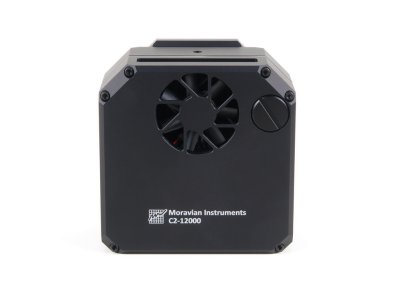
Back side of the C2 camera head contains vents for a
fan, cooling Peltier hot side The cooling performance slightly depends on the amount
of heat generated by a sensor used in the camera:
In general, lower resolution sensors generate less heat
and thus reaches lower temperature. The “A” version cameras, using sensors with
limited read modes, also generate less heat and reaches lower
temperature.
The cooling performance also depends on the environmental
conditions and also on the power supply. If the power supply
voltage drops below 12 V, the maximum
temperature drop is lower.
| CMOS sensor cooling |
Thermoelectric (Peltier modules) |
| Maximal cooling Δ T |
~40 °C below ambient |
| Regulated cooling Δ T |
35 °C below ambient (90%
cooling) |
| Regulation precision |
0.1 °C |
| Hot side cooling |
Forced air cooling (fan) |
Sensor cooling specifications 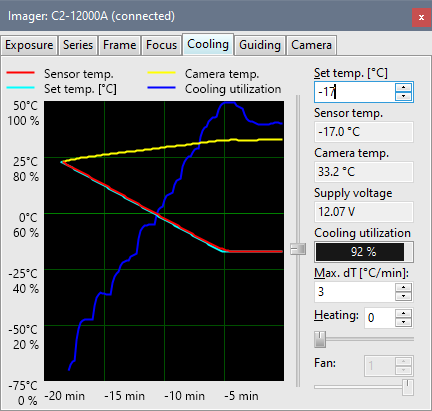
C2-12000A camera reaching -45°C sensor temperature
below ambient Overheating protection
The C2 cameras are equipped with an overheating protection
in their firmware. This protection is designed to prevent the
Peltier hot side to reach temperatures above ~50°C sensor
cooling is turned off to stop heat generation by the hot side
of the Peltier TEC modules.
Turning the overheating protection on results in a drop in
cooling power, a decrease in the internal temperature of the
camera and an increase in the temperature of the sensor.
However, when the camera cools its internals down below the
limit, cooling is turned on again. If the environment
temperature is still high, camera internal temperature rises
above the limit an overheating protection becomes active
again.
Power supply
The 12 V DC power supply enables camera operation
from arbitrary power source including batteries, wall adapters
etc. Universal 100-240 V
AC/50-60 Hz, 60 W “brick” adapter is supplied with
the camera. Although the camera power consumption does not
exceed 40 W, the 60 W power supply ensures noise-free
operation.
| Camera power supply |
12 V DC |
| Camera power consumption |
<4 W without cooling |
| |
26 W maximum cooling |
| Power plug |
5.5/2.5 mm, center
+ |
| Adapter input voltage |
100-240 V AC/50-60 Hz |
| Adapter output voltage |
12 V DC/5 A |
| Adapter maximum power |
60 W |
Power supply specification Warning: The power connector on the camera head uses
center-plus pin. Although all modern power supplies use this
configuration, always make sure the polarity is correct if
other than the supplied power source is used. 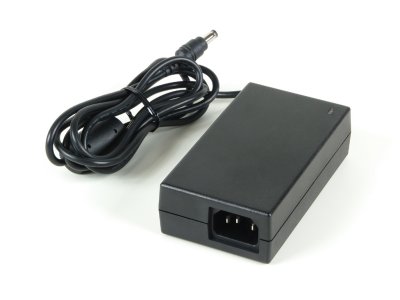
12 V DC/5 A power supply adapter for the C2
camera Mechanical Specifications
Compact and robust camera head measures only 114 × 114 × 65 mm
(approx. 4.5 × 4.5 × 2.6 inches). The head is CNC-machined from
high-quality aluminum and black anodized. The head itself contains
USB-B (device) connector and 12 V DC power plug.
Integrated mechanical shutter allows streak-free image readout, as
well as automatic dark frame exposures, which are necessary for
unattended, robotic setups.
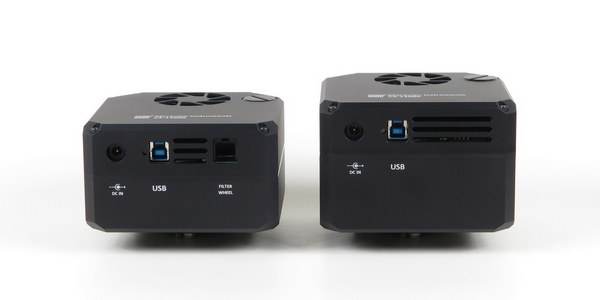
Bottom side of the camera without filter wheel (left)
and with internal filter wheel (right) Camera head with integrated Internal filter wheel is
77.5 mm thick. Filter wheel offers 5 positions
for standard 1.25-inch threaded filter cells. A variant of filter
wheel with 6 positions for unmounted D26 mm filters is also available.
| Internal mechanical shutter |
Yes, blade shutter |
| Shortest exposure time |
125 μs
(electronic shutter) |
| Longest exposure time |
Limited by chip saturation only |
| Internal filter wheel |
5 positions for 1.25" threaded filter
cells or for D31 mm unmounted
filters |
| |
6 positions for 1" or D26.5 mm unmounted filters |
| Head dimensions |
114 mm × 114 mm × 77.5 mm (with internal filter wheel) |
| |
114 mm × 114 mm × 65 mm
(without filter wheel) |
| Back focal distance |
33.5 mm
(base of adjustable adapters) |
| Camera head weight |
1.00 kg
(without filter wheel) |
| |
1.15 kg
(with internal filter wheel) |
| |
1.70 kg
(with “XS” external filter wheel) |
| |
1.95 kg
(with “S” external filter wheel) |
Mechanical specifications Camera with Internal Filter Wheel
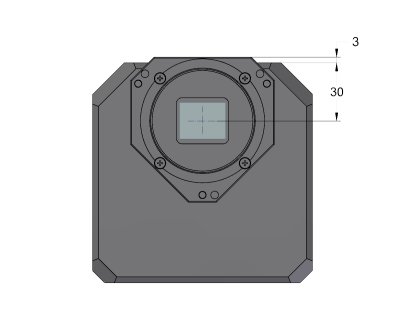
C2 camera head front view dimensions C2 camera head with Internal Filter Wheel side view
dimensions Camera with “XS” External Filter Wheel
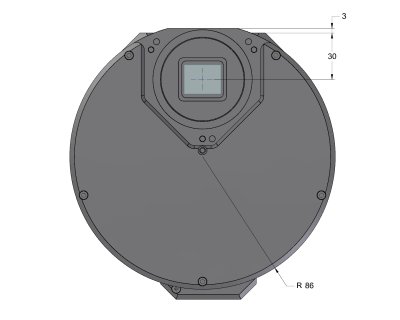
C2 camera head with External filter wheel front
view dimensions C2 camera head with External filter wheel side view
dimensions The “S” sized External filter wheel diameter is
greater (viz. External Filter Wheels), but the back focal
distance of all external filter wheels is identical.
Camera without filter wheel
If the camera model, intended for usage with External
filter wheel, is used without filter wheel at all, two types
of adjustable adapter bases can be used.
When a “thin” adapter base, intended for camera with
Internal filter wheel, is used, the back focal distance is
only 21 mm.
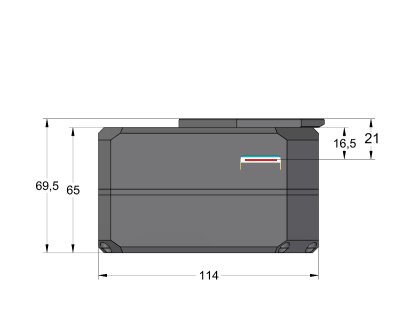
Camera without filter wheel with “thin”
adapter base “Thick” adapter base has the same thickness like the
External filter wheel. This means all adapters, attached to
this thick base, keep the same back focal distance like if
attached directly to External filter wheel shell or to a
camera with Internal filter wheel and “thin” adapter base.
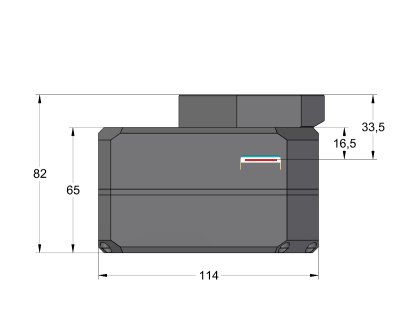
Camera without filter wheel with “thick”
adapter base Back focal distance
The stated back focal distances (BFD) include corrections for
all optical elements in the light path (cold chamber optical
window, sensor cover glass, ...), fixed in the camera body. So,
stated values are not mechanical, but optical back focal
distances. However, no corrections for filters are included, as
the thicknesses of various filters are very different.
C2 cameras are manufactured in many variants and can be
connected with various accessories, which leads to many possible
back focal distance values.
There are two groups of the telescope and lens
adapters, differing in back focal distance definition:
Adapters without strictly defined BFD. These
adapters are designed to provide as low BFD as
possible. Adapter with defined BFD. These adapters are
typically intended for optical correctors (field flatteners,
coma correctors, ...) and also for photographic lenses. Keeping
the defined BFD is necessary to ensure proper functionality of
correctors or to be able to achieve focus with photographic
lenses.
Adapters without back focal distance defined
Most commonly used adapter without strictly prescribed back
focal distance is M48 × 0.75 thread.
C2 camera back focal distances with short
M48 × 0.75
adapter — without filter wheel (left),
with Internal Filter Wheel (center) and with External Filter
Wheel (right) Adapters with defined back focal distance
There are three basic variants of C2 camera, differing with
back focal distance of the camera head front shell — camera without internal filter wheel, with
Internal Filter Wheel with External Filter Wheel. But adapters
preserving back focal distance are always designed with the
same thickness. Their dimension counts with the BFD of the
tiltable adapter base 33.5 mm, which corresponds with BFD of the
camera with External Filter Wheel.
However, adapters not mounted on the External Filter Wheel
tiltable base, must be mounted on standalone tiltable adapter
base attached to the camera head. Such adapter base is
designed to provide exactly the same
33.5 mm BFD when
mounted on camera with Internal Filter Wheel.
If a camera without filter wheel is to be used with adapter
preserving the defined BFD, it is necessary to use a thick
tiltable adapter base, which also provides the
33.5 mm BFD.
Thickness of this adapter base equals the thickness of the
External Filter Wheel shell.
C2 camera with thin 55 mm BFD M48 × 0.75 adapter — without filter wheel (left), with Internal
Filter Wheel (center) and with External Filter Wheel
(right) C2 camera with Canon EOS bayonet adapter — without filter wheel (left), with Internal
Filter Wheel (center) and with External Filter Wheel
(right) C2 camera with Nikon bayonet adapter — without filter wheel (left), with Internal
Filter Wheel (center) and with External Filter Wheel
(right) C2 camera with C3-OAG — without filter wheel (left), with Internal
Filter Wheel (center) and with External Filter Wheel
(right) Optional accessories
Various accessories are offered with C2 cameras to enhance
functionality and help camera integration into imaging setups.
External filter wheels
When there is no filter wheel inside the camera head, all
electronics and firmware, intended to control it, stays idle.
These components can be utilized to control external filter
wheel with only little changes. Also the camera front shell
can be manufactured thinner, the space for filter wheel is
superfluous.

C2 camera with attached External filter
wheel Telescope adapters
Various telescope and lens adapters for the C2
cameras are offered. Users can choose any adapter according
to their needs and other adapters can be ordered
separately.
2-inch barrel — adapter for standard 2" focusers. T-thread short — M42 × 0.75 inner thread
adapter. T-thread with 55 mm BFD — M42 × 0.75 inner thread
adapter, preserves 55 mm back
focal distance. M48 × 0.75
short — adapter with inner thread
M48 × 0.75. M48 × 0.75with 55 mm
BFD — adapter with inner thread
M48 × 0.75,
preserves 55 mm back focal
distance. Canon EOS bayonet — standard Canon EOS lens adapter, preserves
44 mm back focal
distance. Nikon F bayonet — standard Nikon F lens adapter, preserves
46.5 mm back
focal distance.
All telescope/lens adapters of the C2 series of cameras can
be slightly tilted. This feature is introduced to compensate
for possible misalignments in perpendicularity of the
telescope optical axis and sensor plane.
The C2 camera telescope adapters are attached using three
“pulling” screws. As the adapter tilt is adjustable,
another three “pushing” screws are intended to fix the
adapter after some pulling screw is released to adjust the
tilt.
Adjusting the telescope adapter tilt (left) and
removing the tiltable adapter (right) Adjustable telescope/lens adapters are attached
slightly differently depending if the adapter is attached
directly to the camera head (e.g. when camera is equipped
with internal filter wheel) or to the External filter wheel
case.
C2 adapters are not mounted directly on the camera
head. Instead a tilting adapter base, holding the circular
spring, is always used. If the External filter wheel is used, the adapted
base is not necessary, as the External filter wheel front
plate is already designed to hold the spring and it also
contains threads to fix respective adapters.
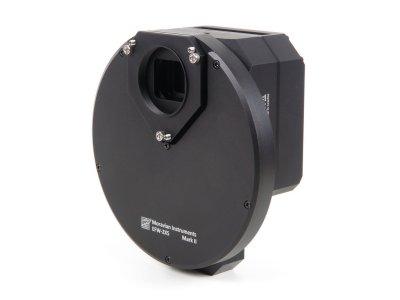
External filter wheels are already designed for
adjustable telescope adapters Off-Axis Guider Adapter (OAG)
C2 camera can be optionally equipped with Off-Axis Guider
Adapter. This adapter contains flat mirror, tilted by 45° to
the optical axis. This mirror reflects part of the incoming
light into guider camera port. The mirror is located far
enough from the optical axis not to block light coming to the
main camera sensor, so the optics must be capable to create
large enough field of view to illuminate the tilted
mirror.
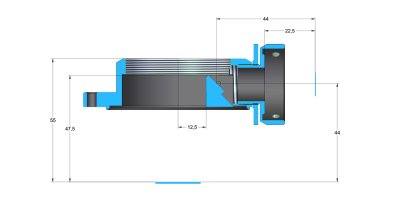
Position of the OAG reflection mirror relative to
optical axis C2-OAG is manufactured in two variants, one with
M42 × 0.75 thread (T-thread) and
another with M48 × 0.75 thread.
Both variants are designed to be compatible with external
filter wheels and to preserve 55 mm distance from the sensor.
C2 OAG with M42 thread (left) and with M48 thread
(right) If the OAG has to be used on camera with internal filter
wheel, the OAG is mounted to adapter base like any other
adapter. Resulting Back focal distance remains the same.
OAG guider port is compatible with C0 and C1 cameras (and
also older G0 and G1). It is necessary to replace the
CS/1.25” adapter with short, 10 mm variant in the case of C1 cameras.
Because C1 cameras follow CS-mount standard, (BFD
12.5 mm), any
camera following this standard with 10 mm long 1.25” adapter
should work properly with the C2-OAG.
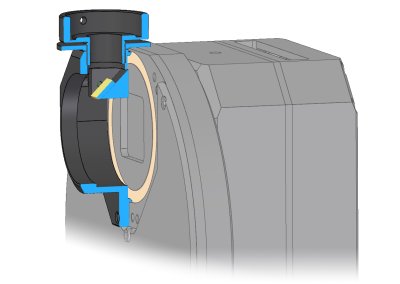
C2-OAG sectional rendering illustrating reflecting
mirror Warning: C1 cameras are available with CS-mount adapter as
well as with T-thread (M42 × 0.75) adapter. To work
properly with C2-OAG, C1 with CS-mount adapter only must be
used. Larger T-thread adapter is not mechanically compatible
with OAG. GPS receiver module
The C2 cameras, both global-shutter and rolling-shutter
variants, can be equipped with an optional GPS receiver
module, which allows very precise timing of the exposure
times. Geographic location data are also available to the
control software through specific commands.
The used GPS receiver is compatible with GPS, GLONASS,
Galileo and BeiDou satellites.
The GPS receiver can be attached to the back side of the
camera head. If the GPS module is removed, the GPS port is
covered with a flat black cover.
Warning: Please note it is necessary to choose GPS-ready
variant upon camera ordering. It is not possible to add a GPS
module to the C2 camera without GPS port. Attaching camera head to the telescope mount
C2 camera heads are equipped with “tripod” thread
(0.25”) as well as four M4 threaded holes on the top side of
the camera head.
Location of the mounting holes for C2 camera
without filter wheel (left) and with the internal filter
wheel (right) This thread can be used to attach 1.75 inch “dovetail bar” (Vixen
standard). It is then possible to attach the camera head, e.g.
equipped with photographic lens, directly to various telescope
mounts supporting this standard.
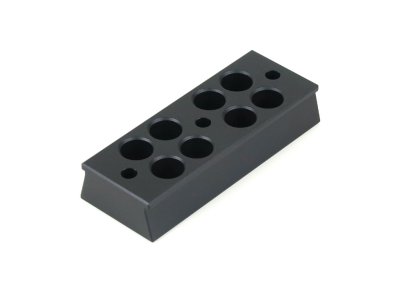
1.75" bar for standard telescope mounts Tool-less desiccant containers
C2 cameras employ the same desiccant container like the
larger C3 and C4 cameras, aw well as CCD based G2, G3 and G4
cameras. The whole container can be unscrewed, so it is
possible to exchange silica-gel without the necessity to
remove the camera from the telescope.
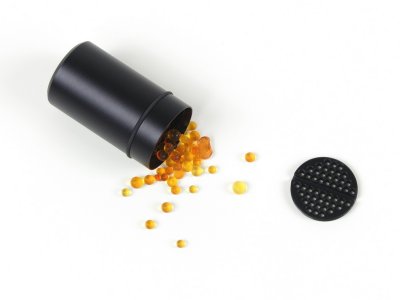
The whole desiccant container can be baked to dry
the silica-gel inside or its content can be poured out after
unscrewing the perforated internal cap and baked
separately Container shipped with the camera by default does not
exceed the camera head outline. It is equipped with a slot for
tool (a plastic tool is included with every camera, but e.g.
some coin can be used, too), allowing releasing and also
tightening of the container.
This design also allows usage of some optional
parts:
Threaded hermetic cap, allowing sealing of the dried
container when it is not immediately attached to the camera
head. Alternate (somewhat longer) desiccant container,
modified to be able to be screw in and tightened (as well as
released and screwed out) without any tool.
Comparison of the standard and tool-less container
(left), optional cap, standard and tool-less variant of the
container Camera head color variants
Camera head is available in several color variants of the
center plate. Visit manufacturer's web pages for current
offering.
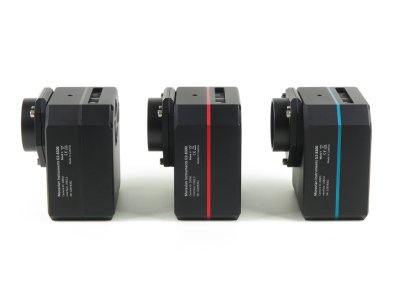
C2 camera color variants Moravian Camera Ethernet Adapter
The Moravian Camera Ethernet Adapter device allows
connection of up to four Cx cameras of any type on one side
and 1 Gbps Ethernet interface on the other side. So, this
device allows attaching of cameras to virtually unlimited
distance using the routable TCP/IP protocol.
The Moravian Camera Ethernet Adapter device (left)
and the adapter with connected two cameras (right) Moravian Camera Ethernet Adapter device is described in
detail here.
Software support
Always use the latest versions of the system driver package for
both Windows and Linux system. Older versions of drivers may not
support new camera models or latest versions or existing
series.
If the camera is controlled through the Moravian Camera
Ethernet Adapter, make sure the device firmware is updated to
the latest version available.
Also, always use the latest version of the SIPS software
package, older versions may not support latest cameras correctly.
If a driver for 3rd party software package is used
(e.g. ASCOM or INDI drivers), always update the driver to the
latest available version.
SIPS
Powerful SIPS (Scientific Image Processing System)
software, supplied with the camera, allows complete camera
control (exposures, cooling, filter selection etc.). Also
automatic sequences of images with different filters,
different binning etc. are supported. With full ASCOM standard
support, SIPS can be also used to control other observatory
equipment. Specifically the telescope mounts, but also other
devices (focusers, dome or roof controllers, GPS receivers
etc.).
SIPS also supports automatic guiding, including image
dithering. Both “autoguider” port hardware interface
(6-wire cable) and mount “Pulse-Guide API” guiding
methods are supported. For hi-quality mounts, capable to track
without the necessity to guide at last during one exposure,
inter-image guiding using the main camera only is
available.
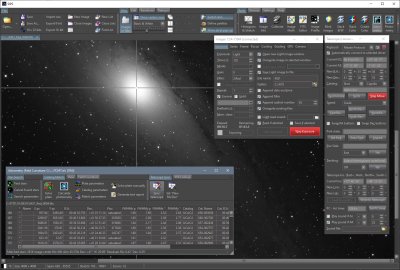
SIPS controlling whole observatory (shown in
optional dark skin) But SIPS is capable to do much more than just camera and
observatory control. Many tools for image calibration, 16 and
32 bit FITS file handling, image
set processing (e.g. median combine), image transformation,
image export etc. are available.
SIPS handles FITS files, supports image calibration
and processing As the first “S” in the abbreviation SIPS means
Scientific, the software supports astrometric image reduction
as well as photometric processing of image series.
SIPS focuses to advanced astrometric and
photometric image reduction, but also provides some very
basic astro-photography processing SIPS software package is freely available for download from this www site. All functions
are thoroughly described in the SIPS User's Manual, installed
with every copy of the software.
Automatic guiding
SIPS software package allows automatic guiding of the
astronomical telescope mounts using separate guiding
camera. Proper and reliable automatic guiding utilizing
the computational power of Personal Computer (e.g.
calculation of star centroid allows guiding with sub-pixel
precision) is not simple task. Guiding complexity
corresponds to number of parameters, which must be entered
(or automatically measured).
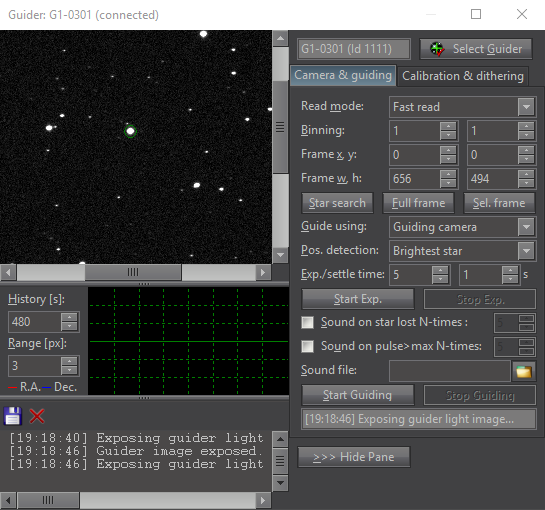
The SIPS “Guider” tool window The “Guiding” tool allows switching of
autoguiding on and off, starting of the automatic
calibration procedure and recalculation of autoguiding
parameters when the telescope changes declination without
the necessity of new calibration. Also swapping of the
German Equatorial mount no longer requires new autoguider
calibration. There is also a graph showing time history of
guide star offsets from reference position in both axes.
The length of graph history as well as the graph range can
be freely defined, so the graph can be adjusted according
to particular mount errors and periodic error period
length. Complete log of calibration procedure, detected
offsets, correction pulses etc. is also shown in this
tool. The log can by anytime saved to log file.
An alternative to classic autoguiding is the
inter-image guiding, designed for modern mounts, which are
precise enough to keep tracking with sub-pixel precision
through the single exposure, and irregularities only
appear on the multiple-exposure time-span. Inter-image
guiding then performs slight mount position fixes between
individual exposures of the main camera, which eliminates
“traveling” of the observed objects through the
detector area during observing session. This guiding
method uses main imaging camera, it does not use another
guiding camera and naturally does not need neither OAG nor
separate guiding telescope to feed the light into it.
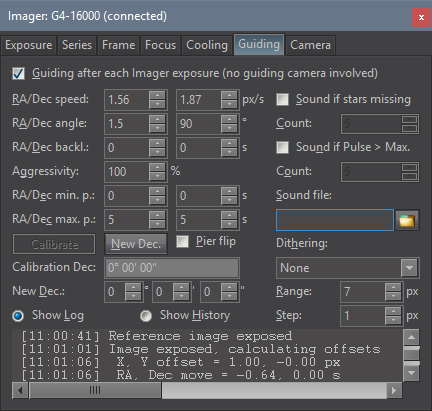
Inter-image guiding controls in the
Guiding tab of the Imager Camera tool
window Advanced reconstruction of color information of
single-shot-color cameras
Color sensors have red, green and blue filters applied
directly on individual pixels (so-called Bayer mask).
Every pixel registers light of particular color only
(red, green or blue). But color image should contain all
three colors for every pixel. So it is necessary to
calculate missing information from values of neighboring
pixels.
There are many ways how to calculate missing color
values — from simple extending of
colors to neighboring pixels (this method leads to coarse
images with visible color errors) to methods based on
bi-linear or bi-cubic interpolation to even more advanced
multi-pass methods etc.
Bi-linear interpolation provides significantly better
results than simple extending of color information to
neighboring pixels and still it is fast enough. But if the
telescope/lens resolution is close to the size of
individual pixels, color artifacts appear close to fine
details, as demonstrated by the image below left.
The above raw image with colors calculated
using bi-linear interpolation (left) and the same raw
image, but now processed by the multi-pass de-mosaic
algorithm (right) Multi-pass algorithm is significantly slower compared
to single-pass bi-linear interpolation, but the resulting
image is much better, especially in fine details. This
method allows using of color camera resolution to its
limits.
SIPS offers choosing of color image interpolation
method in both “Image Transform” and “New Image
Transform” tools. For fast image previews or if the
smallest details are significantly bigger than is the
pixel size (be it due to seeing or resolution of the used
telescope/lens) the fast bi-linear interpolation is good
enough. But the best results can be achieved using
multi-pass method.
Drivers for 3rd party programs
Regularly updated Sofware Development Kit for Windows allows to
control all cameras from arbitrary applications, as well as
from Python scripts etc.
There are ASCOM standard drivers available together with
native drivers for some 3rd party programs (for
instance, TheSkyX, AstroArt, etc.). Visit the download page of this server to see a list of
all supported drivers.
Libraries and INDI standard drivers for 32-bit and 64-bit
Linux working on x86 and ARM processors are available as well. Also drivers for TheSkyX
running on macOS are supplied with all cameras.
Shipping and Packaging
C2 cameras are supplied in the foam-filled, hard
carrying case containing:
Camera body with a user-chosen telescope adapter. If
ordered, the filter wheel is already mounted inside the camera
head and filters are threaded into place (if ordered). A 100-240 V AC input, 12 V DC output
“brick” adapter with 1.8 m
long power cable. 2 m long USB 3.0 A-B cable
for connecting camera to host PC. USB Flash Drive with camera drivers, SIPS software
package with electronic documentation and PDF version of
User's Manual. A printed copy of camera User's Manual
C2 cameras are shipped in the foam-filled carrying case
(left), larger case is used if camera is ordered with external
filter wheel (right) Image Gallery
Example images captured with C2 cameras.
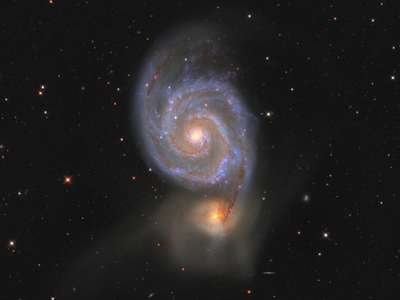 |
| Object |
M51 “Whirlpool Galaxy” |
| Author |
Martin Myslivec |
| Camera |
C2-9000 |
| Filters |
LRGB |
| Exposure |
10 hours (2.5
hour per LRGB channel) |
| Telescope |
400 mm
f/2.9 astrograph |
|
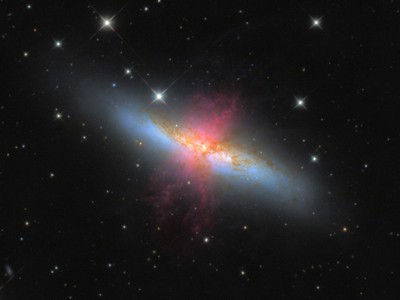 |
| Object |
M82 “Cigar Galaxy” |
| Author |
Martin Myslivec |
| Camera |
C2-12000 |
| Filters |
LRGB and Hα |
| Exposure |
28 hours |
| Telescope |
300 mm
f/3.8 astrograph |
|
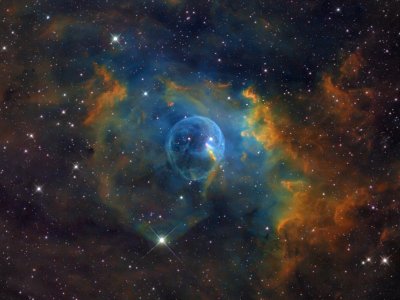 |
| Object |
NGC 7635 “Bubble Nebula” |
| Author |
Martin Myslivec |
| Camera |
C2-12000 |
| Filters |
Hα, OIII and SII |
| Exposure |
21 hours |
| Telescope |
300 mm
f/3.8 astrograph |
|
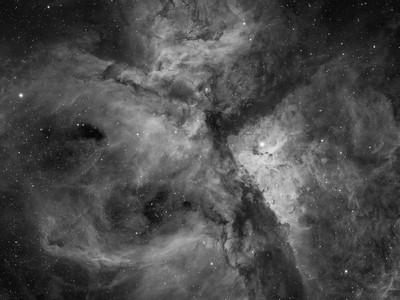 |
| Object |
Eta Carinae nebula |
| Author |
Pavel Pech |
| Camera |
C2-12000 |
| Filters |
Hα |
| Exposure |
3 hours |
| Telescope |
Takahashi FSQ-85EDX |
|
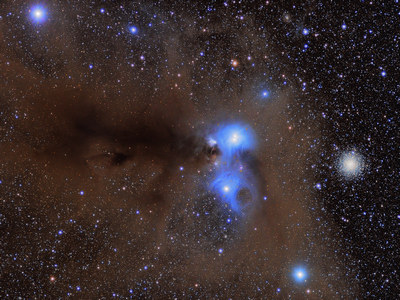 |
| Object |
part of the Corona Australis constellation |
| Author |
Pavel Pech |
| Camera |
C2-12000 (Luninance) + G3-11000 (RGB) |
| Filters |
Luminance |
| |
Color information taken from image acquired with
G3-11000 camera |
| Exposure |
3 hours (Luminance) |
| Telescope |
Borg 77ED |
|
All images published with permission of their respective
authors.
| 